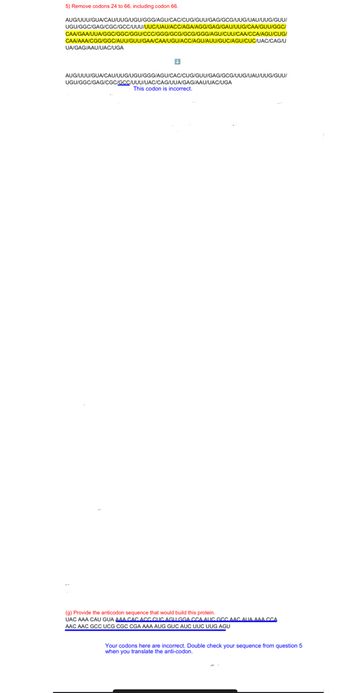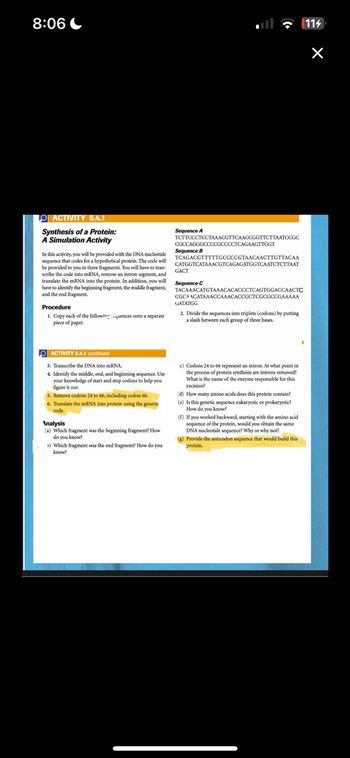
Human Anatomy & Physiology (11th Edition)
11th Edition
ISBN: 9780134580999
Author: Elaine N. Marieb, Katja N. Hoehn
Publisher: PEARSON
expand_more
expand_more
format_list_bulleted
Question
answer both 5 and g i also got an answer for 5 which is TAC/AAA/CAT/GTA/AAC/ACA/CCC/TCA/GTG/GAC/CAA/CTC/CGC/ÀAC/ATA/AAC/CAA/ACA/CCG/CTG/GCG/CCG/AAA/GAG/ATG/GTC/AAT/CTC/TTA/ATG/ACT. Let me know if it’s correct if it is then just give me the answer for G

Transcribed Image Text:5) Remove codons 24 to 66, including codon 66.
AUG/UUU/GUA/CAU/UUG/UGU/GGG/AGU/CAC/CUG/GUU/GAG/GCG/UUG/UAU/UUG/GUU/
UGU/GGC/GAG/CGC/GCC/UUU/UUC/UAU/ACC/AGA/AGG/GAG/GAU/UUG/CAA/GUU/GGC/
CAA/GAA/UUA/GGC/GGC/GGU/CCC/GGG/GCG/GCG/GGG/AGU/CUU/CAA/CCA/AGU/CUG/
CAA/AAA/CGG/GGC/AUU/GUU/GAA/CAA/UGU/ACC/AGU/AUU/GUC/AGU/CUC/UAC/CAG/U
UA/GAG/AAU/UAC/UGA
AUG/UUU/GUA/CAU/UUG/UGU/GGG/AGU/CAC/CUG/GUU/GAG/GCG/UUG/UAU/UUG/GUU/
UGU/GGC/GAG/CGC/GCC/UUU/UAC/CAG/UUA/GAG/AAU/UAC/UGA
This codon is incorrect.
(g) Provide the anticodon sequence that would build this protein.
UAC AAA CAU CUA BAA CÁC ACC CUC AGLLGGA CỦA ALIC GCC AAC ALIA AAA CỦA
AAC AAC GCC UCG CGC CGA AAA AUG GUC AUC UUC UUG AGU
Your codons here are incorrect. Double check your sequence from question 5
when you translate the anti-codon.

Transcribed Image Text:8:06
114
ACTIVITY 5.4.1
Synthesis of a Protein:
A Simulation Activity
In this activity, you will be provided with the DNA nucleotide
sequence that codes for a hypothetical protein. The code will
be provided to you in three fragments. You will have to tran-
scribe the code into mRNA, remove an intron segment, and
translate the mRNA into the protein. In addition, you will
Sequence A
TCTTCCCTCCTAAACGTTCAACCGGTTCTTAATCCGC
CGCCAGGGCCOCGCCCCTCAGAAGTTGGT
Sequence B
TCAGACGTTTTTGCCCCGTAACAACTTGTTACAA
CATGGTCATAAACGTCAGAGATGGTCAATCTCTTAAT
GACT
Sequence C
have to identify the beginning fragment, the middle fragment, TACAAACATGTAAACACACCCTCAGTGGACCAACTC
and the end fragment.
Procedure
1. Copy each of the followingquences onto a separate
piece of paper.
CGCA ACATAAACCAAACACCGCTCGCGCCGAAAAA
GATATGG
2. Divide the sequences into triplets (codons) by putting
a slash between each group of three bases.
ACTIVITY 5.4.1 continued
3. Transcribe the DNA into mRNA.
4. Identify the middle, end, and beginning sequence. Use
your knowledge of start and stop codons to help you
figure it out.
5. Remove codons 24 to 66, including codon 66.
6. Translate the mRNA into protein using the genetic
code.
Analysis
(a) Which fragment was the beginning fragment? How
do you know?
>) Which fragment was the end fragment? How do you
know?
c) Codons 24 to 66 represent an intron. At what point in
the process of protein synthesis are introns removed?
What is the name of the enzyme responsible for this
excision?
(d) How many amino acids does this protein contain?
(e) Is this genetic sequence eukaryotic or prokaryotic?
How do you know?
(f) If you worked backward, starting with the amino acid
sequence of the protein, would you obtain the same
DNA nucleotide sequence? Why or why not?
(g) Provide the anticodon sequence that would build this
protein.
Expert Solution
This question has been solved!
Explore an expertly crafted, step-by-step solution for a thorough understanding of key concepts.
Step by stepSolved in 2 steps

Knowledge Booster
Similar questions
- I was diagnosed with anemia and then heard It is possible that I have leukemia. From my test results can you tell me how I standarrow_forwardPlease Answer the question and explain your answer pleasearrow_forwardWhat scientific developments has Canada made to advance the knowledge the world has on Stroke? State the names of the institutions and scientists involved, names of the projects, funding allocated for this matter, and any other relevant information. *not writing assgiment just q&a*arrow_forward
- PLEASE use in your own words and NOT outside sources just provide the answer itself in brief sentences THANK YOU! 1. When you stand up, gravity causes blood to pool in your legs and abdomen. This decreases arterial blood pressure because there's less blood circulating back to your heart, leading to a condition called orthostatic hypotension. Describe the baroreceptor reflexes in response to this drop in blood pressure. Be as specific as possible.arrow_forwardAnswer letter a,b,d, and e pls.arrow_forwardassessments/797859/variants/843068/take/9/ Question 9 1. Identify the type of tissue in the image below. 2. Support your answer using details from the image that describe the tissue. Answer using 2 to 4 complete sentences. ó õ õ õ ö ö õ 7 of 10 Total Questions Answered All Changes Saved V w 2 2 ✰ ✰ 0 : 4x Continue > 8:14 PM 10/12/2022arrow_forward
- An aneurysm which appears as a balloon-like swelling on the side of an artery is a ____. (It looks like a bubble gum bubble) fusiform infectious saccular scleroticarrow_forward9 X 11 My 11 My accoun: X *C C Broward Pax Opportunit x * ZG Session TX e AD HESI | Case X sevier.com/#/content-player?assessmentVtwld=afcd4cb0-17dd-4437-82f1-ce5cb069ddf9&instanceld-bundle_2207609 b n.com - Onli... New Tab Imported From IE Farmasion. (Enter the numerical value omy, in tounding is necessary, round to the rice tenth.) mL 1 Submit Lo Question 2 of 24 Before giving the initial dose of pain medication or antibiotic, which action should the nurse take first? Ask the client what liquid he would like to drink to swallow the pill. Teach the client the side effects of the medication. Ask the client if he is aware of any allergies to medications. Instruct the client to sit upright to swallow the medication. hp fg f5 Question 3 of 24 f6 J 17 - fe k fio fi ins deletearrow_forwardWhat are the medication for congenital diaphragmatic hernia ? Thank you.arrow_forward
arrow_back_ios
arrow_forward_ios
Recommended textbooks for you
 Human Anatomy & Physiology (11th Edition)BiologyISBN:9780134580999Author:Elaine N. Marieb, Katja N. HoehnPublisher:PEARSON
Human Anatomy & Physiology (11th Edition)BiologyISBN:9780134580999Author:Elaine N. Marieb, Katja N. HoehnPublisher:PEARSON Biology 2eBiologyISBN:9781947172517Author:Matthew Douglas, Jung Choi, Mary Ann ClarkPublisher:OpenStax
Biology 2eBiologyISBN:9781947172517Author:Matthew Douglas, Jung Choi, Mary Ann ClarkPublisher:OpenStax Anatomy & PhysiologyBiologyISBN:9781259398629Author:McKinley, Michael P., O'loughlin, Valerie Dean, Bidle, Theresa StouterPublisher:Mcgraw Hill Education,
Anatomy & PhysiologyBiologyISBN:9781259398629Author:McKinley, Michael P., O'loughlin, Valerie Dean, Bidle, Theresa StouterPublisher:Mcgraw Hill Education, Molecular Biology of the Cell (Sixth Edition)BiologyISBN:9780815344322Author:Bruce Alberts, Alexander D. Johnson, Julian Lewis, David Morgan, Martin Raff, Keith Roberts, Peter WalterPublisher:W. W. Norton & Company
Molecular Biology of the Cell (Sixth Edition)BiologyISBN:9780815344322Author:Bruce Alberts, Alexander D. Johnson, Julian Lewis, David Morgan, Martin Raff, Keith Roberts, Peter WalterPublisher:W. W. Norton & Company Laboratory Manual For Human Anatomy & PhysiologyBiologyISBN:9781260159363Author:Martin, Terry R., Prentice-craver, CynthiaPublisher:McGraw-Hill Publishing Co.
Laboratory Manual For Human Anatomy & PhysiologyBiologyISBN:9781260159363Author:Martin, Terry R., Prentice-craver, CynthiaPublisher:McGraw-Hill Publishing Co. Inquiry Into Life (16th Edition)BiologyISBN:9781260231700Author:Sylvia S. Mader, Michael WindelspechtPublisher:McGraw Hill Education
Inquiry Into Life (16th Edition)BiologyISBN:9781260231700Author:Sylvia S. Mader, Michael WindelspechtPublisher:McGraw Hill Education

Human Anatomy & Physiology (11th Edition)
Biology
ISBN:9780134580999
Author:Elaine N. Marieb, Katja N. Hoehn
Publisher:PEARSON

Biology 2e
Biology
ISBN:9781947172517
Author:Matthew Douglas, Jung Choi, Mary Ann Clark
Publisher:OpenStax

Anatomy & Physiology
Biology
ISBN:9781259398629
Author:McKinley, Michael P., O'loughlin, Valerie Dean, Bidle, Theresa Stouter
Publisher:Mcgraw Hill Education,

Molecular Biology of the Cell (Sixth Edition)
Biology
ISBN:9780815344322
Author:Bruce Alberts, Alexander D. Johnson, Julian Lewis, David Morgan, Martin Raff, Keith Roberts, Peter Walter
Publisher:W. W. Norton & Company

Laboratory Manual For Human Anatomy & Physiology
Biology
ISBN:9781260159363
Author:Martin, Terry R., Prentice-craver, Cynthia
Publisher:McGraw-Hill Publishing Co.

Inquiry Into Life (16th Edition)
Biology
ISBN:9781260231700
Author:Sylvia S. Mader, Michael Windelspecht
Publisher:McGraw Hill Education